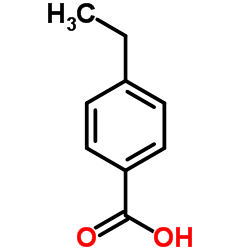4-Ethylbenzoic acid

4-Ethylbenzoic acid structure
|
Common Name | 4-Ethylbenzoic acid | ||
|---|---|---|---|---|
| CAS Number | 619-64-7 | Molecular Weight | 150.174 | |
| Density | 1.1±0.1 g/cm3 | Boiling Point | 270.3±19.0 °C at 760 mmHg | |
| Molecular Formula | C9H10O2 | Melting Point | 112-113 °C(lit.) | |
| MSDS | Chinese USA | Flash Point | 125.1±16.2 °C | |
|
Large-area graphene films by simple solution casting of edge-selectively functionalized graphite.
ACS Nano 5(6) , 4974-80, (2011) We report edge-selective functionalization of graphite (EFG) for the production of large-area uniform graphene films by simply solution-casting EFG dispersions in dichloromethane on silicon oxide substrates, followed by annealing. The resultant graphene films... |
|
|
catena-Poly[[aqua-(4-ethyl-benzoic acid-κO)lanthanum(III)]-tri-μ-4-ethyl-benzoato].
Acta Crystallogr. Sect. E Struct. Rep. Online 66(Pt 2) , m183-4, (2010) The reaction of lanthanum nitrate and 4-ethyl-benzoic acid (EBAH) in aqueous solution yielded the title polymer, [La(C(9)H(9)O(2))(3)(C(9)H(10)O(2))(H(2)O)](n). The asymmetric unit contains one La(III) atom, three 4-ethyl-benzoate (EBA) ligands, one neutral E... |
|
|
Anaerobic activation of p-cymene in denitrifying betaproteobacteria: methyl group hydroxylation versus addition to fumarate.
Appl. Environ. Microbiol. 80(24) , 7592-603, (2014) The betaproteobacteria "Aromatoleum aromaticum" pCyN1 and "Thauera" sp. strain pCyN2 anaerobically degrade the plant-derived aromatic hydrocarbon p-cymene (4-isopropyltoluene) under nitrate-reducing conditions. Metabolite analysis of p-cymene-adapted "A. arom... |
|
|
Redesigning metabolic routes: manipulation of TOL plasmid pathway for catabolism of alkylbenzoates.
Science 235(4788) , 593-6, (1987) Increasing quantities of man-made organic chemicals are released each year into the biosphere. Some of these compounds are both toxic and relatively resistant to physical, chemical, or biological degradation, and they thus constitute an environmental burden o... |
|
|
Effect of tobacco smoke compounds on the plasma membrane of cultured human lung fibroblasts.
Toxicology 15(3) , 203-17, (1980) The ability of compounds derived from tobacco and tobacco smoke to increase the permeability of the membranes of human lung fibroblasts has been studied by measuring the release of an intracellular marker after short term exposure. Of the 464 compounds tested... |
|
|
A metabolite profiling approach to identify biomarkers of flavonoid intake in humans.
J. Nucl. Med. 139 , 2309-14, (2009) Flavonoids are phytochemicals that are widespread in the human diet. Despite limitations in their bioavailability, experimental and epidemiological data suggest health benefits of flavonoid consumption. Valid biomarkers of flavonoid intake may be useful for e... |
|
|
Ruthenium(II)-catalyzed synthesis of hydroxylated arenes with ester as an effective directing group.
Org. Lett. 14(11) , 2874-7, (2012) An unprecedented Ru(II) catalyzed ortho-hydroxylation has been developed for the facile synthesis of a variety of multifunctionalized arenes from easily accessible ethyl benzoates with ester as an efficient directing group. Both the TFA/TFAA cosolvent system ... |
|
|
Study of interactions between food phenolics and aromatic flavors using one- and two-dimensional (1)H NMR spectroscopy.
J. Agric. Food Chem. 48(2) , 407-12, (2000) Changes in flavor release and aroma characteristics in a medium including food phenolics may be attributed to an intermolecular interaction between flavor compounds and phenolics. To investigate the interaction, one- and two-dimensional NMR studies have been ... |
|
|
Regioselective oxidation of indole- and quinolinecarboxylic acids by cytochrome P450 CYP199A2.
Appl. Microbiol. Biotechnol. 85(6) , 1861-8, (2010) CYP199A2, a bacterial P450 monooxygenase from Rhodopseudomonas palustris, was previously reported to oxidize 2-naphthoic acid and 4-ethylbenzoic acid. In this study, we examined the substrate specificity and regioselectivity of CYP199A2 towards indole- and qu... |
|
|
Functional Polymers. VII. Ethyl 4-Vinyl-α-cyano-β-phenylcinnamate. Sumida Y and Vogl O.
Polymer J. 13(6) , 521-36, (1981)
|